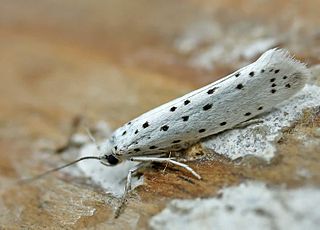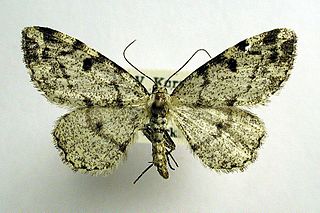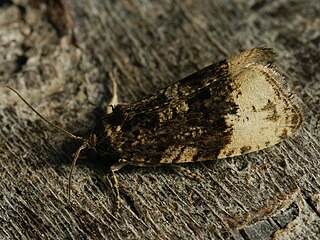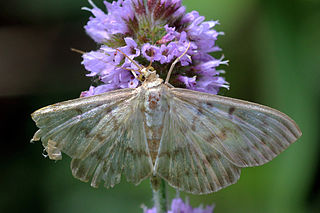Related Research Articles

Yponomeuta padella is a lepidopteran from the family Yponomeutidae, the ermine moths.It is also known as the cherry ermine

Orthosia incerta, the clouded drab, is a species of moth of the family Noctuoidea. It is found in Europe. The occurrence of the species extends through all European countries through the Palearctic to the Russian Far East and Japan. It is absent from northern Fennoscandia. In the Alps it occurs up to 2000 m above sea level.

Lygephila pastinum, the blackneck, is a moth of the family Erebidae. The species was first described by Georg Friedrich Treitschke in 1826. It is found in Europe and across the Palearctic Siberia, the Russian Far East, Japan and China.

Heliothis peltigera, the bordered straw, is a species of moth of the family Noctuidae.

Crambus pratella is a species of moth of the family Crambidae. It is found in Europe and Asia Minor.

Udea olivalis is a species of moth of the family Crambidae. It was first described by Michael Denis and Ignaz Schiffermüller in 1775 and is found in Europe.

Paratalanta pandalis is a species of moth of the family Crambidae. It is found in the Palearctic including Europe.

Falcaria lacertinaria, the scalloped hook-tip, is a moth of the family Drepanidae. The species was first described by Carl Linnaeus in his 1758 10th edition of Systema Naturae It is found in Europe and Anatolia then east to Eastern Siberia.

The pale-lemon sallow is a moth of the family Noctuidae. It is found from Europe to Anatolia and Morocco.

Mythimna straminea, the southern wainscot, is a moth of the family Noctuidae. The species was first described by Georg Friedrich Treitschke in 1825. It is found in the western parts of the Palearctic realm, including Morocco, Europe, Turkey, the Caucasus, Israel, and Lebanon.

Xestia baja, the dotted clay, is a species of moth of the family Noctuidae. It is found in Europe, Turkey, northern Iran, Transcaucasia, the Caucasus, central Asia, Siberia, Mongolia, Tibet, China, Korea and Japan.

Anania fuscalis is a species of moth of the family Crambidae. It is found in Europe.

The silky wainscot is a moth of the family Noctuidae. It is found in most of Europe including Russia.

Denticucullus pygmina, the small wainscot, is a moth of the family Noctuidae. It is found in most of Europe, ranging from northern Spain, through Portugal as far north as Finland. In the east it is found across the Palearctic to the Russian Far East and western Siberia. It is also found in North Africa, Turkey, the Caucasus region and northern Iran.

Alcis jubata, the dotted carpet, is a moth of the family Geometridae. The species was first described by Carl Peter Thunberg in 1788. It is found in central Europe, Scandinavia and northern Italy.

Agonopterix pallorella is a moth of the family Depressariidae. It is found in most of Europe.

Hedya ochroleucana, the buff-tipped marble or long-cloaked marble, is a moth of the family Tortricidae. It is found in most of Europe, except part of the Balkan Peninsula and Ukraine and east across the Palearctic. It is also present in most of North America.

Carpatolechia notatella, the sallow-leaf groundling, is a moth of the family Gelechiidae. It is found in most of Europe and Turkey.

Exoteleia dodecella, the pine bud moth, is a moth of the family Gelechiidae. It is widely distributed from western Europe to Siberia. It is an introduced species in North America.

Patania ruralis, the mother of pearl moth, is a species of moth of the family Crambidae. It was described by Giovanni Antonio Scopoli in 1763. It is found in Europe.